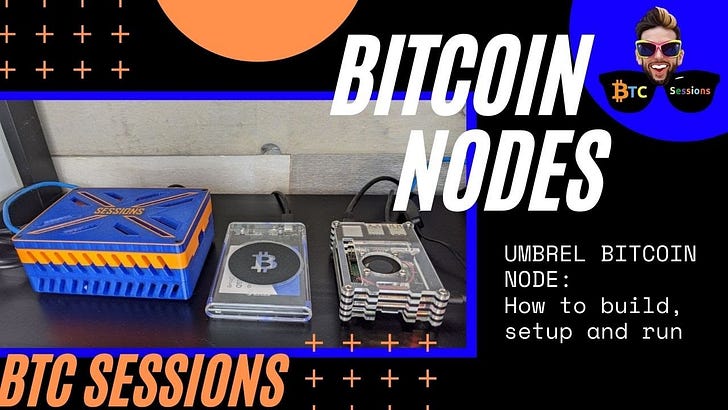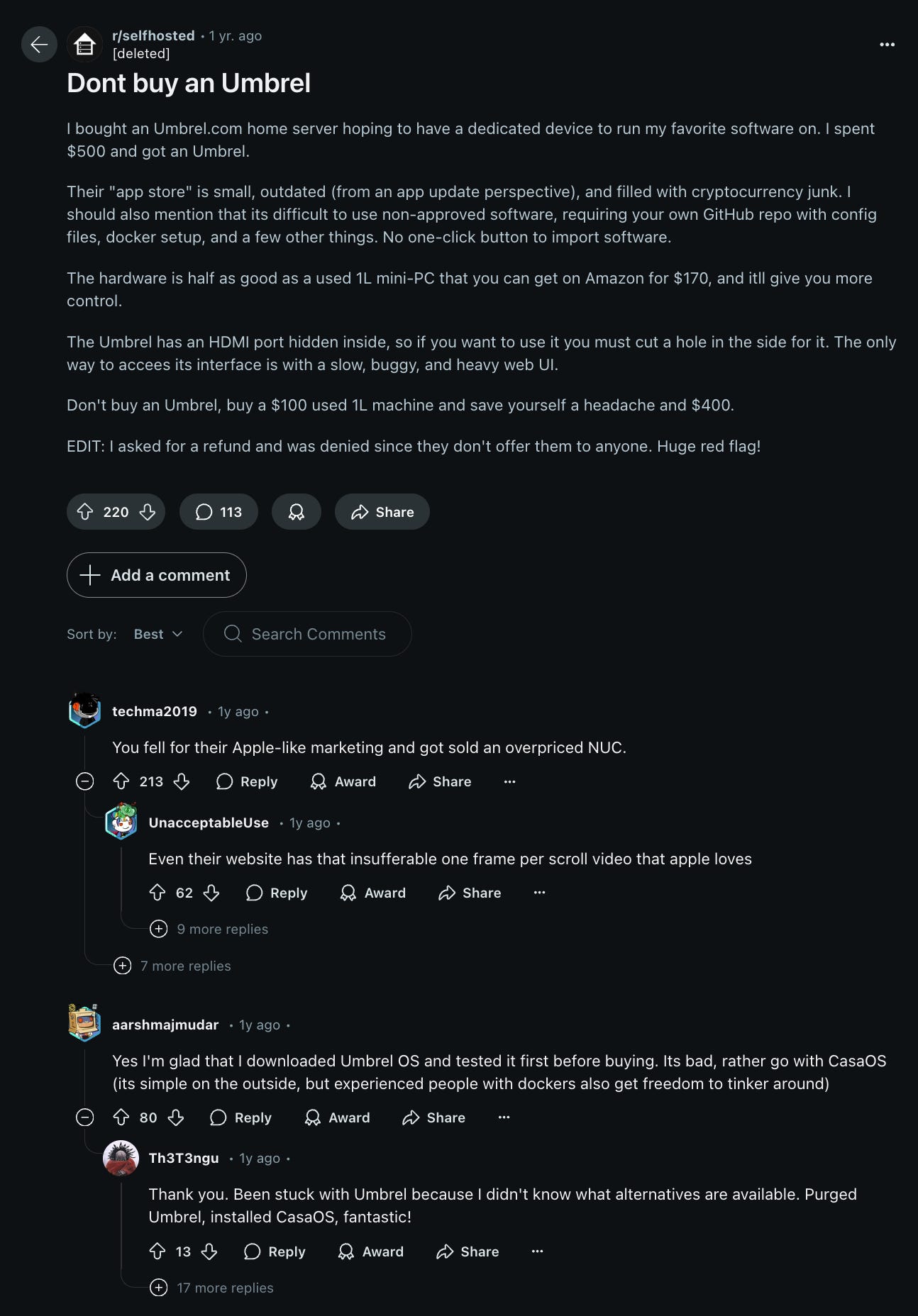What is going on with Umbrel?
"The guys at umbrel have unfortunately managed to start to disperse their 'captive audience.'"
With its price hovering in the $100k range along with approvals of ETFs, the rise of Microstrategy, and President-Elect Trump’s “embrace,” Bitcoin is nonetheless spent significant amount of time recently in the limelight. For hardcore Bitcoiners, much of this is an indication of upcoming hyperbitcoinization.
One part of the Bitcoin ethos that seems to be out of the mainstream spotlight is the ability to run your own node. Unlike mining, which requires far more technical skills and specialized expensive power-hungry equipment running a node is something anybody can do and contributes to the decentralized and sovereign nature of the network. I won’t go into the details on why here as there are plenty of resources out there1 but one way to do this and one that was marketed as being cheap and user-friendly was Umbrel.
Umbrel started out mainly as a Bitcoin and Lightning node. It was simple, all someone had to do but purchase a Raspberry Pi4 (I do believe at one time the older 3 models were supported), a microSD card to store the OS, a minimum 1TB drive (most opted for SSD), a power supply, and an ethernet cable. Umbrel brought the OS, a modified version of RaspianOS with the Bitcoin software and some other Bitcoin related applications.
Umbrel got a lot of press in Bitcoin circles including step by step guides from the famous YouTuber and Bitcoiner BTC Sessions.
And detailed tutorials such as those by
which were translated to several languages.It also received a lot of coverage in the Bitcoin Magazine as being a part of a Bitcoiner’s journey into self-sovereign "cloud-less” computing along with competitors such as Start9. Umbrel was seen as successful onboarding thousands, if not tens of thousands of Bitcoiners to the “don’t trust, verify” ethos of node running. In the fall of 2021, it was estimated that up to 90% of Lightning nodes were running Umbrel. It was also uber-popular among Bitcoin Twitter and Bitcoin enthusiasts wishing to expand the Lightning Network which is seen by many Bitcoiners as one of the solutions to scale the network and to make it easier to use as a form of digital cash without relying on the blockchain for everyday transactions.
With the use of its built-in tor capability along with Tailscale support, an Umbrel user could easily use it anywhere with extreme privacy or extreme convenience. The system grew with a number of Bitcoin related “apps” including Liquid node capability, Mempool visualizers, and eventually added cloud alternatives such as Nextcloud, ebook and media servers, and home automation apps. It also included various instructions on how to connect virtually every major Bitcoin or Lightning wallet available on desktop/laptops and mobile devices to use the node.
Umbrel’s developers eventually raised a few million in seed money from fans and investors and decided to release their own computer product, the Umbrel Home, a mini PC with specs far better than the Raspberry Pi for $430. While similar computers can be purchased for far less, the Home was seen as an easy off-the-shelf no technical skills required workaround. They released support for other x86 machines too sometime along the line and began to develop a version for the new Raspberry Pi 5.
The sky seemed limitless.
Until it wasn’t.
There have always been issues with slow microSD cards, certain power supplies, certain models of HDDs or SSDs that caused problems with the Raspberry Pi platform. Many of the original Umbrel users have 1tb hard drives or SSDs which limited the size of their “personal cloud” and the Bitcoin Blockchain has grown to almost take up the size of a formatted 1tb storage device. To be fair, these aren’t pressing issues on the Umbrel Home product.
Also what came were the bugs, the endless calls for help on Umbrel’s support forum, X, and Telegram pages.
People including myself began to experience issues all over the place on a system that once worked flawlessly. It also turns out that unexpected power outages or surges could wreak havoc on the devices. To be fair again, much of this is the Raspberry Pi platform and could easily be solved with a UPS battery backup but arguably some of it has to do with the code in the Umbrel software itself which the developers never seemed to make immune to these shutdowns. Anecdotally, power outages didn’t cause any problems to my other nodes, Home Assistant server, or PiHole - all of which run on the same hardware as the Umbrel.
Umbrel went away from users trying to download and use the OS on these devices, apparently dropping support all together for the Raspberry Pi 4. Yet these users continued to receive updates to the latest version, 1.3 which as caused lots of users to reach out in support for a variety of issues.
Umbrel’s X account is more than happy to retweet various photos and screenshots of Bitcoiners proud to be running a node but completely ignore users who complain of having issues from simply updating their version as Umbrel encouraged them to do.
Umbrel also don’t provide their PGP keys so that users can actually verify whether any versions of the OS they download can be verified to have not been compromised by a malicious party.
The Umbrel website turned into a confusing mess - it’s sleek and great at marketing the new Home computer and the OS itself, but the developers removed the links to the Githib page and the instructions on how to install the OS on non-Home hardware such as the Raspberry Pi. That makes it difficult for people to try out the OS to get a feel for it before buying the Home, which is really intended to run their software and their software is part of the whole Umbrel experience. The Github page implies that the version compatible with the Raspberry Pi 4 is no longer being actively developed. Instructions for the new Umbrel OS - the one intended really for the Home mini-computer product contain language specific to the newer Raspberry Pi 5.
These complaints are summarized further in my post Open Letter to Umbrel Devs over on the Umbrel support forums which is allegedly not really staffed or monitored regularly by the developers.
The questions remains, what is going on with Umbrel? It’s reasonable to expect that end users who did not explicitly purchase the Home computer are somewhat on the lower end of the totem pole?
Umbrels at one time and may still be in use in circular bitcoin communities such as Bitcoin Lake in Guatemala and Bitcoin Beach in El Salvador. Many of the node runners in such communities are every day people with other things to do and often don’t have the technical skills or even English speaking ability to play around in terminals, dumping log files, or be doing general troubleshooting when Umbrel’s software bugs and issues pop up. Umbrel node runners are all over the world with some with significant liquidity on the Lightning network.
These are the people trying to build Bitcoin, the way it was meant to be, from the ground up.
Perhaps there’s turmoil and infighting among the developers?
Perhaps they’re cashing out for the most part with the Home product?
Perhaps they don’t actually know that so many people are having problems?
Or maybe they just don’t care, instead wanting people to purchase the Home computer product?
But it’s accurate to say just as one support forum member said, “The guys at umbrel have unfortunately managed to start to disperse their “captive audience.”
I don’t want to speculate too much more on what’s going on behind the scenes at Umbrel, but thousands of Bitcoiners put their trust in Umbrel’s software, Home device or not, and many are being burned.











